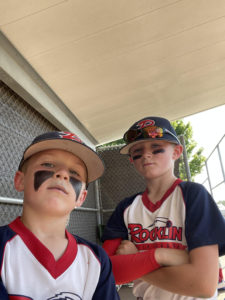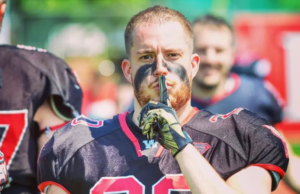Today, eye black is commonplace in all levels of football. From elementary school kids playing in their first Pop Warner game to pros in the NFL suiting up on Sunday’s eye black is everywhere.
Despite how common it is, many do not know where eye black originates from or the purpose for wearing it.
There are countless reasons why players choose to wear eye black for football, but let’s take a look at some of the top reasons as well as the different type of eye black that is used by youth football players up to the NFL level.
Contents
Top 3 Reasons why football players wear eye black
Below are some of the main reasons football players wear black paint on their faces:
1. Reduces Glare
The first reason that football players wear eye black is to reduce glare. This is something that is especially important for players that play positions like quarterback, running back, wide receiver, cornerback, safety, and return kicks.
At times without eye black, the ball can get lost in the sun or bright lights making it a lost cause for the player to even try to make the catch. With eye black, it helps reduce the glare of the sun making it easier to see.
2. Improves visual contrast
A second reason why players wear eye black is to help improve the visual contrast. Along with reducing the glare, improving the visual contrast makes it easier to see the ball and differentiate which player is on which team.
3.Gives players confidence
The final major reason why football players wear eye black is to give them confidence. At times players will have their eyes black done in a certain design that makes them more confident in how they will perform or to kill some of the stress of playing in front of a crowd.
Others will wear eye black for fashion similar to wearing cleats and arm sleeves from designer brands. When eye black is worn, for this reason, it is not to give the player a tactical on-the-field advantage, however, it does add some fun to the game and makes the players more comfortable.
What are the different types of Eye Black?
Here are a few of the most popular types of eye black you will see football players wear:
1. War Paint
The first type of eye black we will be covering is war paint. War paint is more of a liquid that gives a smeared look when it is applied to a person’s cheek.
Earlier in the history of the NFL some, hard hitting defensive players would wear this kind of eye black as a form of intimidation and to play into the tough guy look. This is still a popular look today and one that likely will not be going away anytime soon.
2. Roll on Eye Black
The next form of eye black is roll-on eye black. This eye black is similar to paint in how it looks and feels. However, roll-on eye black is applied almost like lipstick right on the upper cheekbone. It comes in a similar shaped tube to lipstick as well.
3. Eye black stickers
The final form of eye black that we will be looking at is the adhesive eye black stickers. This kind of eye black is pretty self-explanatory. It comes in packs just like stickers and is applied the same way. With the eye anti-glare stickers, you just apply them under your eyes and you are good to go.
What is Eye black made out of?
Anti Glare Eye black has been used for centuries and has gone through many renditions on what ingredients are used. The current ingredients used in the making of modern eye black according to Jere Longman from the New York Times are, “beeswax, paraffin and charcoal powder, while antiglare stickers are made of patented fabric with a dull, matte finish”. Throughout the history of eye black, it has kept a natural formula, even in the modern recipe that is used today.
Does Eye Black actually do anything?
Since it has been introduced to football, many have had their doubts about eye black and how effective it is in truly reducing the glare from the sun, if it even helps at all. The jury is still out on this argument.
There are some who refuse to use it and claim it is “stupid” and “doesn’t” work. While on the flip side, other players swear by eye black and would not be caught dead suiting up without it.
According to Dr. Brian M. DeBroff in an interview with the New York Times, “We were surprised to find a benefit from the grease. Certainly, in football and baseball, where tracking a ball at high speed is an important aspect, any competitive advantage could be beneficial, but I would be highly doubtful that it would have much of an effect if any,” Fuld said.
Why do football Players put black under one eye?
There is no competitive edge to wearing eye black under only one eye. If a player is doing this, they either did not feel like putting it under the other eye or they are only wearing the eye black on one eye as a fashion choice.
What is football war paint?
Football war paint refers to the act of wearing eyes black in a way to intimidate your opponent. As previously mentioned, this was something very common in earlier eras of football where big-hitting players would “put on war paint” in the form of eye black. This would further add to the myth behind them as a player and make them even more feared by their opponents.
Do baseball players wear eye black?
Yes, it’s not just football players who wear eye black, but also in other outdoor sports like baseball. Athletes wear eye black in baseball for the same reason as they do for football.
While you will likely see standard eye black designs in the major leagues, the youth levels have taken their creativity to the next level with their designs.
Summary
In conclusion, eye black is something that football players wear to help reduce glare, improve visual contrast or for personal reasons to make themselves feel more confident. There are three popular forms of eye black, war paint, roll on eye black, and eye black stickers.
Although there has not been much scientific evidence to back up the effectiveness of eye black, players still swear by it and wear it every game.
Whether it is something that actually does help players see or simply a placebo effect that makes them more confident, eye black is something that spices up the game of football and makes it more exciting.




